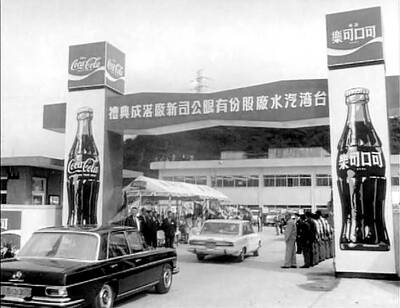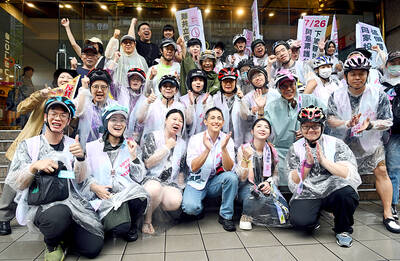Ku Shih-yung (顧世勇) isn’t known for making accessible art. His 2006 solo exhibition at Taipei’s Museum of Contemporary Art (MOCA) included video, bubbles, bells, wax, trumpets and even a life-size dummy attached to a balloon floating above the museum that reportedly prompted a call to police about a possible suicide attempt. The former dean of the College of Visual Arts at Tainan National University of the Arts has penned dense essays on art and theory that reference aspirin-conducive writers like French psychoanalyst Jacques Lacan and philosopher Gilles Deleuze.
Given Ku’s reputation, Oh! Formosa (美哉台灣) at IT Park Gallery (伊通公園) appears deceptively simple. The 49-year-old presents nine large digitally retouched photographs and two smaller unaltered pictures collected from old political magazines and flea markets. The images romanticize “the good-old days” when the sun always shone and beach babes frolicked in the sand.
The average Taiwanese no longer believes the Chinese Nationalist Party’s (KMT) promise of “a brighter tomorrow” and has lost hope in the sullied idealism the Democratic Progressive Party once expounded, Ku says. Many prefer to dwell in a utopian past that may never have existed outside their imagination.
LIVING THE DREAM
Nothing too complicated about that. So is the show a sea change for Ku? Yes and no, he says.
“In the past my art didn’t pay much attention to its place within Taiwan’s context, but now I’m thinking more about it: political, economic and social problems. [I’m examining] the Taiwanese dream from 1949 until now, and I include a little criticism: If we’re going to really face reality, we have to first abandon this dream.”
Ku laughs when I tell him that even my Taiwanese friends find his writing and some of his art hard to understand. He admits his new works are less “artsy,” but says his concept has changed very little. Themes of “peace” and “utopia” in Oh! Formosa can be found in earlier works such as Bubble Man (2006) that hung above MOCA and its antecedent, a 1999-2000 video in which the artist blows a giant bubble that carries him into space, only to burst and send him hurtling back to the earth in a ball of flame.
BREAKING THE MOLD
Ku also stresses a cornerstone of his work that hasn’t changed in 27 years.
After following the conservative curriculum at National Taiwan University of Arts in Banciao, Taipei County, his graduate exhibition consisted simply of photographs of him sitting in a chair, viewed from behind, with nondescript views such as a window or wall in front of him. He called the series Where Do I Sit? and the works showed no reference to the formal techniques he had studied.
“My ‘hand’ in the works I make isn’t important,” he says. “The expression is.”
His statement echoes basic conceptualist dogma that for decades has pitted “idea” art against “formal” art and continues to generate heated intellectual discussion.
Ku’s current show seems an effort by an insider to bring this discussion out of the highfalutin art circle and into the mouths and minds of everyday people. If so, his biggest challenge will be the same that many contemporary artists face: convincing the general public to drop by the gallery and give it a gander.
For those hesitant to make the trip to IT Park for a relatively small show, there are two nearby galleries also worth checking out: VT Art Salon is next door and 50m down the road is the newly opened Sakshi Gallery Taipei — a branch of its Mumbai, India-based namesake — that opens its second show of Indian art on Saturday.

July 28 to Aug. 3 Former president Chiang Kai-shek (蔣介石) reportedly maintained a simple diet and preferred to drink warm water — but one indulgence he enjoyed was a banned drink: Coca-Cola. Although a Coca-Cola plant was built in Taiwan in 1957, It was only allowed to sell to the US military and other American agencies. However, Chiang’s aides recall procuring the soft drink at US military exchange stores, and there’s also records of the Presidential Office ordering in bulk from Hong Kong. By the 1960s, it wasn’t difficult for those with means or connections to obtain Coca-Cola from the

No one saw it coming. Everyone — including the Chinese Nationalist Party (KMT) — expected at least some of the recall campaigns against 24 of its lawmakers and Hsinchu Mayor Ann Kao (高虹安) to succeed. Underground gamblers reportedly expected between five and eight lawmakers to lose their jobs. All of this analysis made sense, but contained a fatal flaw. The record of the recall campaigns, the collapse of the KMT-led recalls, and polling data all pointed to enthusiastic high turnout in support of the recall campaigns, and that those against the recalls were unenthusiastic and far less likely to vote. That

Taiwan is today going to participate in a world-first experiment in democracy. Twenty-four Chinese Nationalist Party (KMT) lawmakers will face a recall vote, with the results determining if they keep their jobs. Some recalls look safe for the incumbents, other lawmakers appear heading for a fall and many could go either way. Predictions on the outcome vary widely, which is unsurprising — this is the first time worldwide a mass recall has ever been attempted at the national level. Even meteorologists are unclear what will happen. As this paper reported, the interactions between tropical storms Francisco and Com-May could lead to

A couple of weeks ago the parties aligned with the People’s Republic of China (PRC), the Chinese Nationalist Party (KMT) and the Taiwan People’s Party (TPP), voted in the legislature to eliminate the subsidy that enables Taiwan Power Co (Taipower) to keep up with its burgeoning debt, and instead pay for universal cash handouts worth NT$10,000. The subsidy would have been NT$100 billion, while the cash handout had a budget of NT$235 billion. The bill mandates that the cash payments must be completed by Oct. 31 of this year. The changes were part of the overall NT$545 billion budget approved